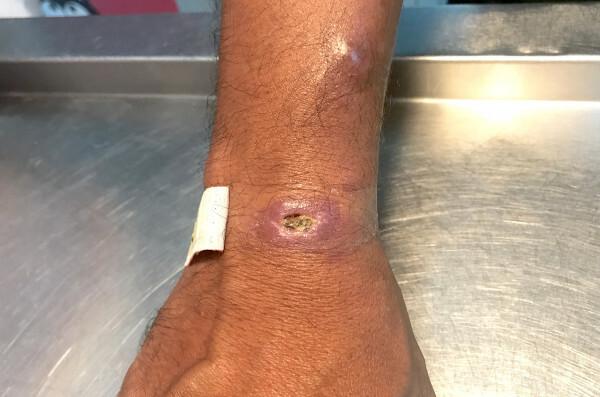A sporotrichosisIt's a fungal infection caused by species of the genus Sporothrix. These fungi are found mainly in soil and decomposing materials, being characteristic of tropical climates. Sporotrichosis can affect both humans and other animals, especially cats. Transmission occurs when there is contact between skin wounds and the fungus through thorns, branches and other contaminated materials or through scratches or bites from sick animals. The main symptom is multiple skin lesions, both in humans and other animals.
The disease is treatable in humans and felines with the use of antifungals, the duration of treatment depending on the severity of the infection. To prevent the disease, it is advisable to wear protective clothing when handling soil materials, plants and decaying materials, as well as isolating sick animals to prevent spread. The increase in cases is mainly related to the abandonment of cats and the lack of population control policies, such as castration, and treatment for sick animals.
Read too: Mucormycosis — the “black fungus” disease
Summary on sporotrichosis
- Sporotrichosis is a mycosis caused by species of the genus Sporothrix, fungi found mainly in soil and decomposing materials.
- There are two species responsible for most cases in Brazil: Sporothrix schenckii and Sporothrix brasiliensis, the latter corresponding to around 90% of cases in the country.
- Infection occurs through contact of skin wounds with the fungus. Contact with the fungus can occur through handling contaminated soil and decomposing materials. It also occurs due to bites or scratches from sick animals.
- Cats are the main vectors of transmission of sporotrichosis caused by the fungus to humans. Sporothrix brasiliensis.
- The most common form of the disease is characterized by skin lesions, both in humans and other animals.
- Treatment in humans and felines involves the use of antifungal medications. The duration depends on the severity of the disease and the patient's condition.
- Prevention includes wearing protective clothing when handling soil materials and isolating sick animals, avoiding direct exposure to the fungus.
- The increase in cases is related to the abandonment of cats, lack of population control policies and environmental degradation.
What is sporotrichosis?
Sporotrichosis It's an infection caused by fungi (mycosis) of the genus Sporothrix, which are found in the soil and in decomposing materials, such as twigs, leaves and wood, and are characteristic of tropical climates. This disease manifests itself when there is contact between the deeper parts of the skin and the fungus, usually through a cut. The most common clinical form of sporotrichosis is characterized by multiple skin lesions, both in humans and other animals, especially in cats.
Until the end of the 1990s, sporotrichosis it was known as the "gardener's disease" or the "rose bush disease" due to its high incidence in gardeners, farmers and people who manipulate plants or soil in rural environments. The main fungus causing this disease, until then, was Sporothrix schenckii, a low virulence species.
What is the relationship between sporotrichosis and cats?
In recent years, the disease has become increasingly common in the Brazilian urban environment due to the presence of the species Sporothrix brasiliensis as an infectious agent, which currently accounts for 90% of cases in Brazil. Cats are highly susceptible to this species of fungus and, due to this characteristic, your organism acts as a vector in the transmission of the disease from cat to cat and also from cat to human being, contributing to the high infectivity rate.
In Brazil, cases of sporotrichosis with this species were recorded mainly in Rio de Janeiro and São Paulo. However, the fungus has spread to other states in the country and even to Argentina and Paraguay due to the flow of sick animals. Currently, the disease is considered a zoonosis and a public health issue. in large urban centers.
Important: Transmission of the disease by cats occurs unintentionally, as they can come into contact with the fungus Sporothrix brasiliensis during your outdoor activities, such as hunting or playing. That way, cats have no control over this transmission and are also victims of the disease. In addition to taking care of the health of felines, it is important to avoid the spread of false information regarding this subject, in order not to contribute to the unjustified increase in aversion to these animals. |
Causes and transmission of sporotrichosis
Sporotrichosis occurs due to inoculation of the fungus through wounds caused by wood chips, soil, decaying materials and thorns contaminated with the fungus. Furthermore, contamination in humans can also occur through bites and scratches from sick cats fungus carriers.
Cats can also acquire the disease by coming into contact with the fungus in the soil, as well as from infected cats. It is important to highlight that transmission of the fungus by inhalation is rare, as well as transmission between humans and from humans to cats.
Environmental degradation over the years has contributed to the increase in the incidence of this disease. Factors such as deforestation, urban expansion and the spread of waste have negatively impacted ecosystems, unbalancing them and exposing animals to new pathogens. Furthermore, the increase in cases of sporotrichosis is directly related to the growing number of abandoned cats, as well as the lack of effective policies to control the population of these animals, such as castration and adequate treatment of sick cats.
See too: What is the relationship between environmental impacts and the emergence of diseases?
What are the symptoms of sporotrichosis?
The fungus, after entering the body, has an incubation period of one week to one month, and can last up to six months.
→ Symptoms of the sporehuman trichosis

In humans, sporotrichosis is a benign disease that generally only affects the skin (cutaneous). The initial lesion is characterized by a small reddish nodule, similar to an insect bite, and can spread throughout the skin and reach mucous membranes, such as the eyes and mouth, in more severe cases. serious.
Sporotrichosis can also be extracutaneous, so as to affect internal organs and can compromise different regions of the body. When sporotrichosis affects the lungs, the patient may experience shortness of breath, pain when breathing, cough and fever. If sporotrichosis affects the bones and joints, it may manifest as swelling and pain when moving, similar to infectious arthritis.
→ Symptoms of sporotrichosis in domestic animals
In domestic animals, especially felines, the most common symptoms are deep skin wounds, usually with blood and/or pus, which do not heal and can evolve. In addition, the animal may also experience frequent sneezing. In felines, skin wounds can spread throughout the body and progress quickly.

Is sporotrichosis curable?
Sporotrichosis There is a cure and there are treatments available for both cats and humans. Therefore, cats suspected of having sporotrichosis should not be mistreated, abandoned or euthanized. It is essential to seek a doctor or veterinarian as soon as any injury is identified, thus avoiding the disease evolves into a serious condition and complicates treatment, in addition to reducing the risk of streaming.
Know more: Other diseases that affect animals and humans
Treatment of sporotrichosis
→ Treatment of human sporotrichosis
Treatment of sporotrichosis in humans is generally involves the use of antifungal medications such as itraconazole. After clinical evaluation, the doctor will be able to guide the patient regarding the dose and duration of the medication. treatment, taking into account the severity of the disease and the individual conditions of each patient. The disease is not considered serious, but people with low immunity They must take special care and seek appropriate treatment as soon as possible.
The duration of treatment can vary from three to six months and can last up to a year., and it is essential that it is not interrupted during the process. The medicines necessary to treat sporotrichosis in humans are available free of charge through the Health Surveillance Secretariat.
→ Treatment of sporotrichosis in animals
For the treatment of domestic animals, the use of antifungals is also recommended. Just like in humans, the affected cat must undergo a clinical evaluation and be seen by a veterinarian, who will be able to prescribe the correct dose and duration of treatment. The animal's improvement is gradual after starting treatment, and it is generally advisable to continue it until at least two months after the lesions have disappeared and hair growth has returned in the affected areas.
During this process, It is important to clean the environment where the sick animal lives to reduce the presence of fungi, in addition to keeping the animal well fed and isolated from other animals in the house. The use of gloves when dealing with a sick animal is essential to avoid contamination.
Important:Euthanasia is an option to be considered only in cases of animals with no prospect of treatment, that is, situations very serious cases in which there is no possibility of cure, and the decision must be made by the veterinarian.
How to prevent sporotrichosis?
There is not yet a vaccine available to prevent sporotrichosis, although studies are ongoing. Therefore, The main preventive measure is to avoid direct exposure to the fungus. It is recommended to use long-sleeved clothing and gloves when handling materials from the soil and plants, in addition to sick pets in order to prevent scratches, bites or skin contact injured.
You Affected animals must be isolated of healthy animals, kept at home and undergoing treatment prescribed by the veterinarian. Restricting the animal from leaving the house is essential to avoid contamination by other animals and, consequently, the transmission of the disease to humans and other animals, perpetuating the cycle of illness.
In the event of death or euthanasia of the sick animal, the body must be incinerated.. Throwing it in the book or in vacant lots, or even burying it, contributes to soil contamination by the fungus. In situations of contact with stray animals suspected of having sporotrichosis, it is important to contact contact the Zoonosis Control Center in your city or use the official channels provided by the city hall.
Furthermore, it is important demand public policies aimed at reducing animal abandonment, population control through the castration of stray animals and appropriate treatment for them. Policies that promote access to information about the disease for the population can also play a significant role in reducing cases of sporotrichosis.
Sources
Virtual Health Library. Ministry of Health. Sporotrichosis. Available in: https://bvsms.saude.gov.br/esporotricose/
Centers of Disease Control and Prevention (CDC). Sporothrix brasiliensis | Fungal Diseases. Available in: https://www.cdc.gov/fungal/port/sporotrichosis/brasiliensis.html
Oswaldo Cruz Foundation (Fiocruz). Sporotrichosis. In: Fiocruz Portal. Available in: https://portal.fiocruz.br/esporotricose
Oswaldo Cruz Foundation (Fiocruz). Sporotrichosis: questions and answers. In: Fiocruz Portal. Available in: https://portal.fiocruz.br/esporotricose-perguntas-e-respostas
Ministry of Health. Human sporotrichosis. Available at: < https://www.gov.br/saude/pt-br/assuntos/saude-de-a-a-z/e/esporotricose-humana
Brazilian Society of Dermatology. Sporotrichosis. Available in: https://www.sbd.org.br/doencas/esporotricose/
VideoSaúde Distributor of Fiocruz. 2016. Sporotrichosis | with Libras. YouTube. Available in: https://www.youtube.com/watch? v=8aHlZ5X-hJ8
Zhang, Y. et al. 2015. Phylogeography and evolutionary patterns in Sporothrix spanning more than 14 000 human and animal case reports". Mol Phyl Evol Fungi. 35 (1): 1–20.

